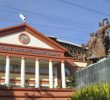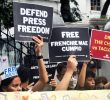DAVAO CITY – On the second year anniversary of typhoon Pablo (International name Bopha), survivors and support groups claimed that they remained displaced, this time by what they claimed was an insensitive relocation program of the government.
According to Barug Katawhan (Stand Up, People) spokesperson, Carlos Trangia, instead of giving them the appropriate on-site housing, the government placed them far from their farms and sources of livelihood.
“The housing program of the government was placed where we need to walk for one whole day before reaching our farms,” Trangia said.
Pablo victims and supporters mounted a protest here this week to commemorate the second year anniversary of Pablo, which entered on December 4, 2012 through Davao Oriental to Compostela Valley and northwest to Agusan del Sur and Agusan del Norte.
Trangia said that they had an agreement with Social Welfare secretary, Corazon “Dinky” Soliman, that the houses of the victims should be built near their farmlands. “But it was not followed because the DSWD considered the farmlands as “danger zones”.
Trangia argued that “there are hurricanes, earthquakes, and other natural disasters in which even those who live in highways and poblacions will not be spared”.
He said that if there is a natural calamity, it will be a “one blow for all of the 1,214 typhoon survivors” who are beneficiaries of the government housing in San Roque, New Bataan, Compostela Valley.
According to National Housing Authority, there are only 538 units that were built so far in one town in Cateel, Davao Oriental: 167 units in Barangay San Alfonso, 289 units in San Antonio, and 82 units in Taytayan.
In Compostela Valley Province, the NHA built 2,967 units in the towns of New Bataan (1,214 units are built in barangay San Roque, 50 in Andap), Monkayo (225 units in Union and 443 units in Lower Ulip), barangay New Visayas in Montevista (335 units), barangay Maparat, Compostela (300 units), and barangay Kidawa, Laak (400 units).
Trangia also said that the housing program is a form of “hamletting”.
According to Trangia, the housing project in San Roque was put up near the military camp of 66th Infantry Battalion of the Armed Forces of the Philippines (AFP).
“They monitor the actions of the people in the community,” Trangia said.
Trangia cited the killing of a farmer and Pablo survivor Gregorio Galacio who was “murdered in his own house in Kahayag, New Bataan in July 19 this year as an incident affecting the security of peasant activists.”
University of the Philippines, Professor Kim Gargar of Panalipdan (Defend), an environmentalist organization in Southern Mindanao said that the housing project is also an “opening act” for the foreign mining companies to enter Pablo affected areas.
“It is another form of disaster towards the survivors of typhoon Pablo. The housing program of the government is used as a tool to displace the farmers away from their lands,” Gargar said during the protest action in front of the Mines and Geosciences Bureau (MGB) Region XI, Thursday.
Meanwhile, Rose Andaya, 39-year old resident of barangay Abihan in Cateel, Davao Oriental, told Davao Today that up to now, they have not yet recovered from the damages brought by typhoon Pablo.
“The housing provided for the survivors of Pablo in Cateel are 5-6 hours away walking distance and more than an hour motorcycle ride from our farm lands and we could not afford to rent a motorcycle which costs Php 1,500 per ride,” Andaya said.
Andaya said that they bear the long walk because they don’t have the money to pay for the motorcycle ride.
Andaya also lamented that the roads from their farms to the market are only passable by single motorcycles making it hard for them to sell their products.
Another resident of Cateel, Junior Solapas, said that “they still suffer from the effects of the typhoon” because of government inaction.
Solapas, whose wife was still under trauma, was left with no choice but to work both as a laborer and a farmer to feed their 5-year old child.
“We cannot depend on our farm productions nowadays, because of the weather,” Solapas said.
Solapas also said that they are disappointed with the quality of the house from the government.
He said that the house provided was “just made out of coconut lumber which will easily be destroyed by strong winds.”
“The ceiling is coco lumber and there is no flooring,” he added. “Where are the calamity funds and other aids for the Pablo survivors?” he asked.
The survivors’ dismay on government response prompted them to unite and extend help to one another.
Trangia said that their farm rehabilitation program, “Balik Tikad sa Uma” has already started and will be implemented to other places in Davao Oriental.
“We are helping each other. There are also non-government organizations and schools in Davao who assist us to build sustainable and organic agriculture,” Trangia said.
Three months after the typhoon, the Ateneo de Davao University’s EcoTeneo, a student organization, together with Tulong Kabataan (Relief Network of Kabataan Partylist), and BALSA Mindanao, held a tree planting activity in different towns in Compostela Valley.










